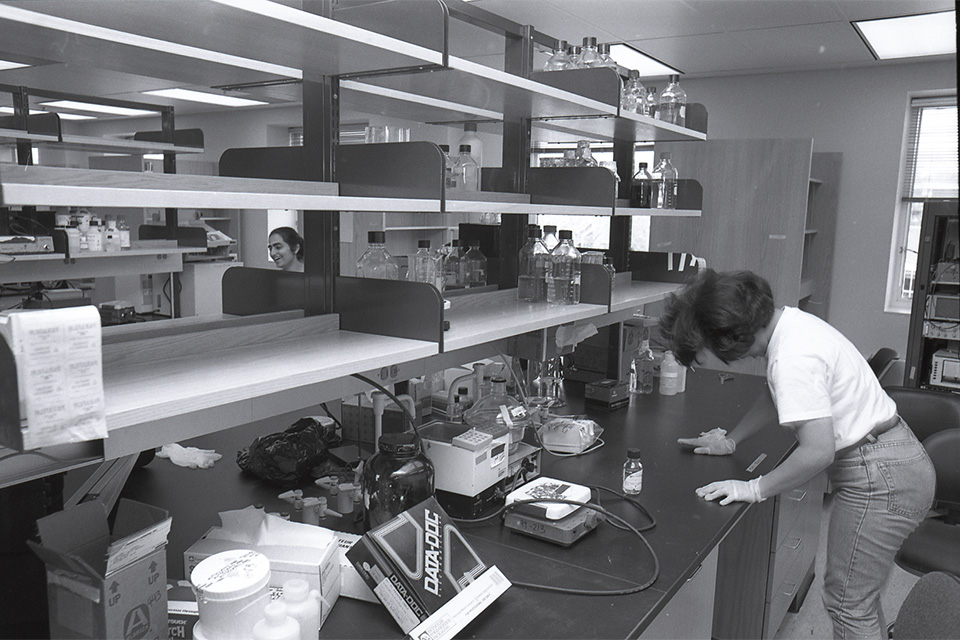Research

Readying a new Volen Center lab for move-in day (1994)
Photo Credit: Courtesy of the Robert D. Farber University Archives & Special Collections Department, Brandeis University.
Training Faculty Collaborations
The Neuroscience community in the Volen Center is a tight-knit group with many collaborative projects. This interconnected environment greatly enhances the training of our students who get broad exposure to many intellectual frameworks and experimental approaches. The extent of the collaborative environment can be seen in the publication list of the training faculty profiles.
Fai is generating image processing tools to extract how the spatial and biochemical organization of the presynaptic periactive zone relates to vesicle release probability, using Rodal's data.
Avital Rodal, Suzanne Paradis and Michael Rosbash
These investigators have been collaborating to study the role of TDP-43 in dendritic growth. Three published papers.
Paul Miller and Stephen Van Hooser
Miller and Van Hooser build circuit models of the development of motion selectivity in primary visual cortex. These models produce experimental predictions that are tested in Van Hooser's lab. Three published papers.
Suzanne Paradis, Stephen Van Hooser and Eve Marder
These labs are focusing on a gene, Rem2, that is required for normal synapse formation, dendritic branching and functional plasticity. Two published papers and a third manuscript in preparation.
Donald Katz, Gina Turrigiano and Stephen Van Hooser
Turrigiano's lab is a world leader in the study of homeostatic synaptic plasticity that occurs in the developing cortex in slice or culture. In this collaboration, Katz and Van Hooser's labs brought in vivo physiological recordings and imaging techniques to the study of homeostatic plasticity in living animals. Three published papers, and a fourth is in preparation.
A joint postdoc is using cutting-edge molecular and ensemble physiology tools to analyze the molecular underpinnings of conditioned taste aversion and relate learning-related patterns of gene expression to the network activity driving naïve and learned behavior. One published paper and another under revision.
Angela Gutchess and Donald Katz
Patterns of preferences for tastes and taste mixtures in human subjects are being studied, and the specific socio-cultural mechanisms for preferences in eastern and western subjects are probed. A paper is in preparation.
Genetic tools are being used to enrich our understanding of how cholinergic innervation of forebrain structures engender naïve and experience-dependent behavioral responses to tastes. One published paper.
Shantanu Jadhav and Donald Katz
These PIs are studying the interaction of taste and place coding in the hippocampus. Two published papers.
Irving Epstein, Eve Marder and Jonathan Touboul
These labs have collaborated to study dynamical systems. Three published papers.
Gina Turrigiano and Sacha Nelson
These PIs continue their 25-year collaboration on the molecular and cellular mechanisms of homeostatic plasticity in the rodent neocortex. They are working to understand the role of transcriptional regulators in homeostatic plasticity. Twenty-seven published papers.
Gina Turrigiano and Suzanne Paradis
Turrigiano and Paradis collaborate to design RNAi probes to knock down elements of signaling pathways involved in homeostatic plasticity and test potential protein-protein interactions using biochemical approaches. One published paper.
Michael Rosbash, Sacha Nelson and Sebastian Kadener
These PIs collaborate on the roles of microRNAs in neuronal identity and plasticity in flies and mice. Members of the Rosbash and Nelson labs have co-authored several papers on cell type specific mRNA and small RNAs. A new exciting collaboration concerns RNA binding protein specificity in discrete neurons. All three PIs have one published paper together.
Piali Sengupta, Paul Garrity and Eve Marder
Sengupta was the PI of a recently completed P01 (with Garrity, Marder and two investigators at Harvard) investigating temperature compensation. The overall goal of this project was to investigate the mechanisms underlying temperature detection and compensation in invertebrate model systems, and dovetails with work in the Marder lab on temperature. Sengupta and Garrity are currently examining the properties of novel classes of thermoreceptors they have identified. They have two published papers together.
Piali Sengupta and Stephen Van Hooser
The labs collaborated on neuronal mechanisms of thermosensory adaptation with Van Hooser applying advanced data analysis techniques to data collected in the Sengupta lab. One published paper.
Jennifer Gutsell and Angela Gutchess
These PIs are investigating the extent to which young adults resonate to younger and older adult targets, and connecting the degree of motor resonance (an EEG measure of mu suppression) to memory. Gutsell’s prior work reveals that people resonate less to outgroup members, which is typically defined on the basis of race. This study extends the research to in- and outgroup members defined on the basis of age. One published paper so far.
Leslie Griffith and Paul Garrity
Griffith and Garrity have collaborated extensively on the cellular nature of temperature sensation. Griffith's electrophysiological expertise and interest in circuits extended Garrity's molecular/genetic studies in the basic mechanisms of sensory transduction. The two labs have a joint lab meeting that enriches trainees in both labs and facilitates technical collaborations. Four joint published papers.
Leslie Griffith and Michael Rosbash
Griffith and Rosbash share an interest in the cellular and molecular basis of sleep. Rosbash's background in circadian clocks and molecular biology complements Griffith's interest in plasticity and neuronal function. The sleep groups in both labs regularly attend each other's lab meeting. Nine collaborative papers.